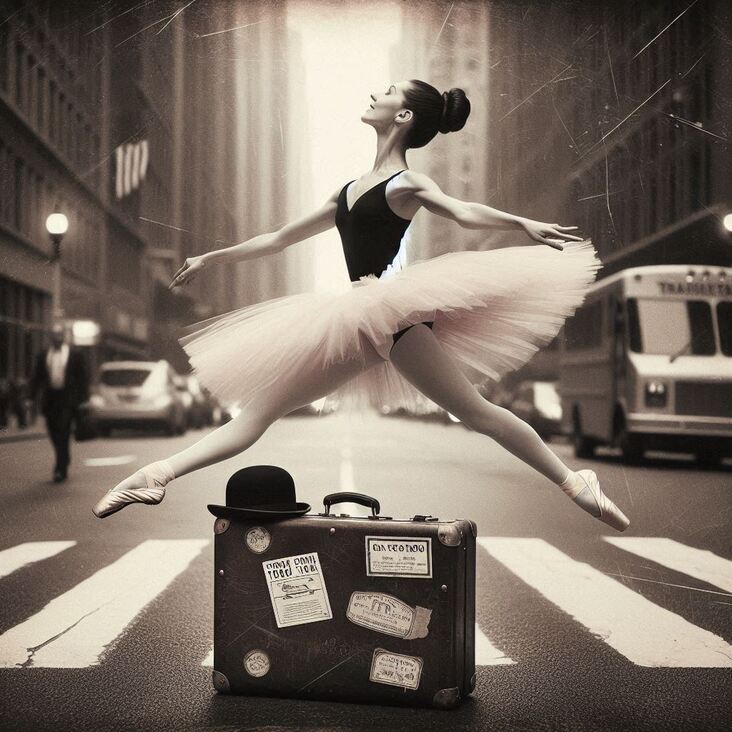
Hello darlings!
It's Tuesday, which means it's time for another #TutuTuesday post! I'm currently zipping through time, and guess what? I landed right in the heart of Paris, and guess what else? It's the 10th of July 2012!
This is the perfect day to talk about the evolution of the tutu, because we're in the heart of ballet's history, right?
First of all, let me just say, Parisian ballet dancers always have such amazing style. Even on a normal Tuesday, they're looking effortlessly elegant. It’s all so chic.
Right now I’m in a fabulous tea room with a huge window overlooking the Palais Garnier - you know, the iconic opera house designed by Charles Garnier.
Imagine it: all those famous ballerinas who danced on those legendary stages! Marie Taglioni, Anna Pavlova, Carlotta Grisi. It's truly incredible to think about the incredible history this building has witnessed, and to think I can see it today is like a dream.
Anyway, what's so amazing about tutus? They are a symbol of artistry, elegance, and grace, and even a tiny hint of whimsical fantasy! Plus they’re just plain pretty! There's nothing quite like a ballerina gracefully gliding across the stage in a perfectly-fitted, airy tutu, do you agree? It's pure magic, right?
Today I'm dressed in my prettiest pink tulle tutu and a vintage, hand-sewn velvet bolero I found at a vintage store back in Derbyshire. I’m ready to go and enjoy this stunning city in the best way I know how. That's why I'm spending this gorgeous July afternoon sipping hot tea, observing the Parisian style and pondering the past and present of the tutu.
So, where did the tutu as we know it start?
It’s time to delve into a little ballet history...
Believe it or not, the first tutus weren't all airy tulle and frills. It's a fun bit of history. Back in the 16th century, it was all about these voluminous gowns, like elaborate court dress. They were HUGE and restricting. I’m talking yards and yards of fabric, seriously!
Can you imagine how hard it was for dancers to even move in those massive skirts?
The 1800s marked a revolution in both fashion and dance! Romanticism came to the fore and we see more flowing, delicate skirts coming into play. Then Taglioni, a revolutionary ballerina, appeared, and her famous, short, white, airy skirt caused a huge sensation. And that my lovelies, is the very start of the tutu we know and love.
It was called the “tulle dress,” and it's a direct descendant of classical Romantic ballet. Can you even imagine all the stories behind each of those iconic tutues? And what of their creators, the artists who meticulously hand-sew each layer of fabric with precision and passion?
By the 19th Century, these light tulle dresses began to be more elaborate, and more structured.
Remember the "Crinoline?" It wasn't all frills. Yes, It helped make skirts larger, but it also became associated with female empowerment. And, just like the tutus, its airy elegance symbolized freedom!
Even in the Victorian era, we saw a softening of the skirt shape. Ballet was transitioning towards more expressive styles, like "The Nutcracker". We even saw some "panniers" still being used as well.
Then came the 20th Century, and with it came new techniques, styles and designers.
I love reading about all of these legendary fashion houses like Balenciaga, Christian Dior, Coco Chanel – they changed the way people thought about design. All of this revolutionary creativity influenced not only fashion, but also dance design!
It is here we see the famous “tutu” as we know it emerge. And oh, my lovelies, is it EVER a spectacle! I just love how we see the ballet world’s influence on fashion, and how in return fashion influences dance.
And in this wonderful ballet universe, we have different types of tutus to delight in. Let's get back to this 20th-century explosion! The "Romantic Tutu" – like the ones you often see in ballet - has its own distinctive qualities, all in delicate, transparent tulle.
Then there’s the "Classical Tutu" which is even shorter and looks much more streamlined, very much inspired by those gorgeous, 19th-century fashions, and still incredibly elegant!
This was the period in which tutus were reaching their most structured and defined forms. It was also an age of many revolutions in ballet: modern dance, new approaches to dance design...
We were now at the heart of the tutus we see today, and a big part of its evolution came from designers working with different fabric weights and tulle patterns to create different silhouettes. We have so many more layers and possibilities to play with. The "tutu” is very fluid these days, not simply tied to any one rigid shape or structure. It can be romantic, playful, bold, elegant, simple. We have so many possibilities!
That, darlings, is just the beginning of the Tutu history. You can imagine what awaits us in the future - tutus are evolving and there's just so much we have to explore, new shapes, colors, materials, styles!
What are some of your favorite tutu moments in ballet? Let me know!
And, in the meantime, it’s time to go have some more tea and watch the world go by. Until next time!
Keep twirling!
Emma

